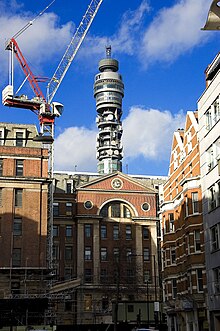Middlesex Hospital
The Middlesex Hospital was a hospital in London district of Fitzrovia . It was founded in 1745 and closed in December 2005.
The original location was on Windmill Street and was named after Middlesex County . It was not a hospital as it is today. Anyone who fell ill in Britain at the time was usually cared for at home. Hospitals of this time were welfare institutions, in which needy people were admitted free of charge in the event of illness, if they could show a letter of recommendation from one of the supporters. Middlesex Hospital initially had 18 beds, and a maternity ward was added in 1747. In 1757 Middlesex Hospital moved to Mortimer Street. Hugh Percy, 1st Duke of Northumberland, laid the foundation stone for the new building in 1755. In 1836 the hospital was officially recognized as a charity. In 1854 it played a role in caring for the sick during the severe cholera epidemic. Florence Nightingale , who was running a small nursing home on Harley Street at the time , which only housed impoverished middle-class British women, was temporarily released from running the nursing home and volunteered to care for cholera sufferers at Middlesex Hospital. Medics who worked intermittently at Middlesex Hospital in the second half of the 19th century included William Henry Flower and John Whitaker Hulke .
Middlesex Hospital expanded over the next few decades, not least because of the increasing importance of hospitals for general health care in the UK with industrialization and the resulting urbanization of the population. Hospitals in the modern sense developed after 1846, when the increasing spread of modern anesthesia made other forms of interventions possible, but also required organized and careful all-day care of the patients treated. The renovation work also includes the commission of the British symbolist Frederick Cayley Robinson (1862–1927) to execute four allegorical paintings for the entrance area of the hospital. These four large paintings, called Acts of Mercy , address the themes of illness and welfare. They are now in the Wellcome Collection .
In 1924 it was decided that the hospital needed a complete renovation. The funds of more than £ 1 million were raised through donations from the UK public. The foundation stone was laid by the Duke of York, who later became King George VI. On May 29, 1935, he also opened the completely renovated building. In 1992, Middlesex Hospital was merged with the Teaching Hospital of University College London . The hospital closed in December 2005. The main buildings of the former hospital were sold for £ 180 million to an investor who had them demolished in 2008. Former outbuildings of the hospital are now used by University College London and the National Health Service .
Single receipts
- ↑ Mark Bostridge: Florence Nightingale . Penguin Books, London 2009, ISBN 978-0-140-26392-3 , p. 93
- ↑ Mark Bostridge: Florence Nightingale . Penguin Books, London 2009, ISBN 978-0-140-26392-3 , p. 199
- ↑ Mark Bostridge: Florence Nightingale . Penguin Books, London 2009, ISBN 978-0-140-26392-3 , p. 94.
- ^ Frederick Cayley Robinson: Acts of Mercy in the National Gallery, London . Accessed April 6, 2011
Coordinates: 51 ° 31 '8.4 " N , 0 ° 8' 15.7" W.
